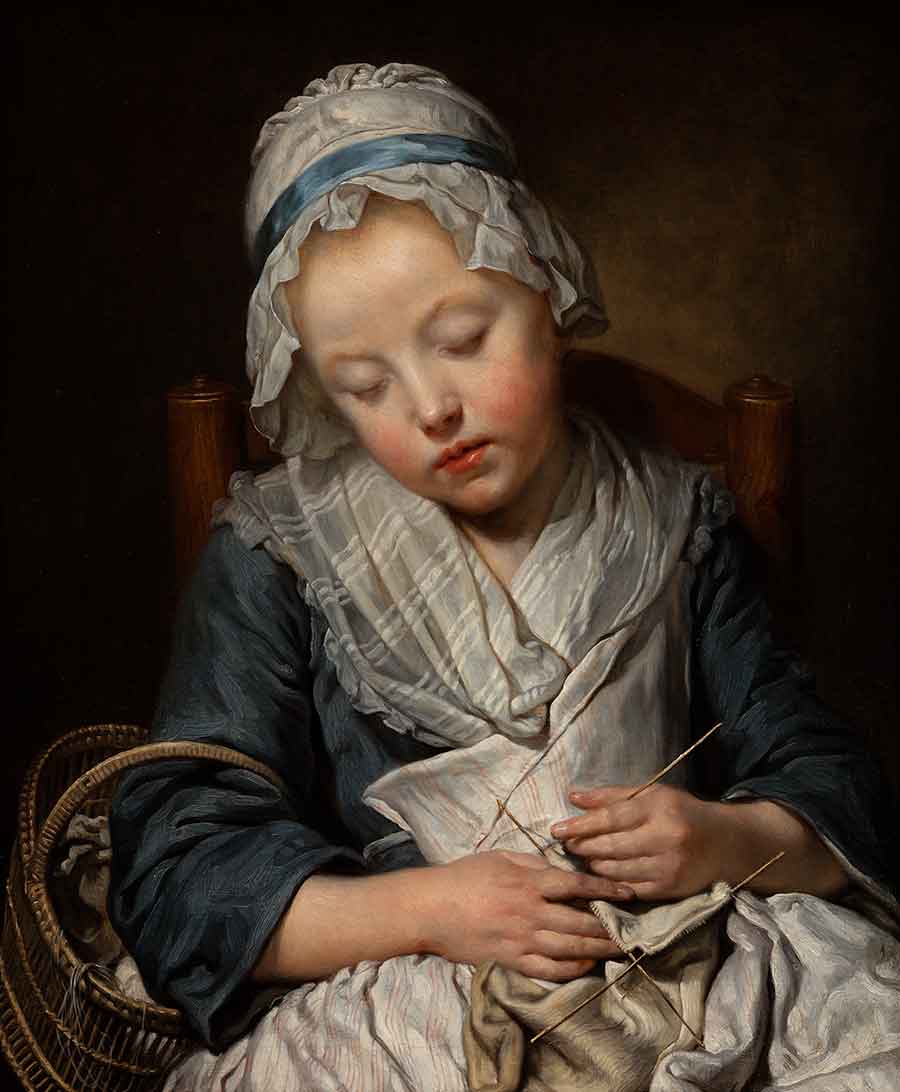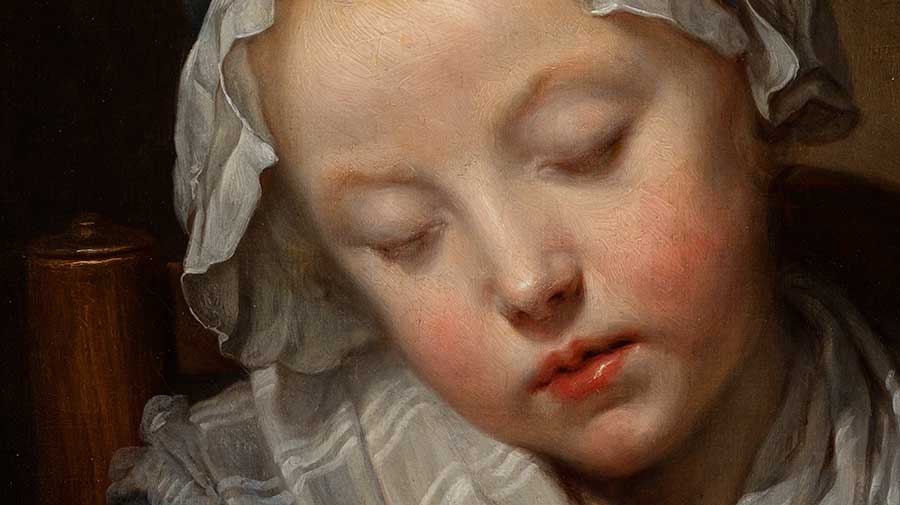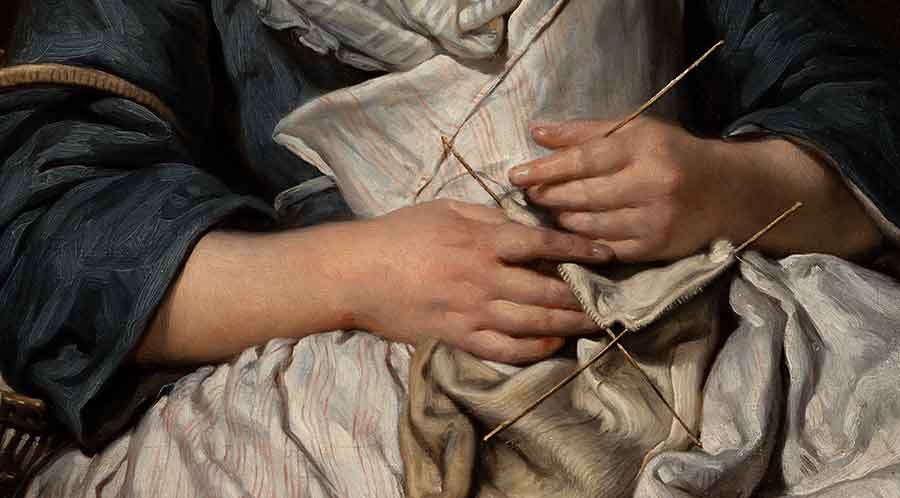The Huntington’s blog takes you behind the scenes for a scholarly view of the collections.
Young Knitter Asleep
Posted on Wed., May 20, 2020 by

Jean-Baptiste Greuze, Young Knitter Asleep, ca. 1759, oil on canvas, 27 x 22 in. Adele S. Browning Memorial Collection, gift of Mildred Browning Green and Honorable Lucius Peyton Green. The Huntington Library, Art Museum, and Botanical Gardens.
A beloved painting on the second floor of the Huntington Art Gallery has stolen hearts on a regular basis. Access to the image is now a virtual experience while The Huntington remains closed due to COVID-19.
Young Knitter Asleep is the work of Jean-Baptiste Greuze (1725–1805), a painter who was popular in 18th-century France among both critics and the public. Beyond the charm of the young subject, deeper readings of the picture may be particularly relevant today as many parents are called upon to serve as teachers to their children, especially now that schools have been closed due to the coronavirus.
First: the charm. Greuze depicts his sitter in all her youthful beauty with rosebud lips; healthy plumpness; and delicate, porcelain-like skin. Looking closely, one can even perceive her skin’s translucency where a few thin, blue veins appear on her forehead. With great skill, Greuze renders her flesh with fine, subtle brushstrokes, creating smooth transitions among the various tones of pink, white, beige, and brown. However, he masterfully varies the opacity and texture of his brush strokes throughout the painting. Areas of looser brushwork convincingly depict thin gauze, slick ribbon, dense wool, and stiff wicker.

Greuze depicts his sitter in all her youthful beauty with rosebud lips and delicate, porcelain-like skin. Jean-Baptiste Greuze, detail of Young Knitter Asleep, ca. 1759, oil on canvas, 27 x 22 in. Adele S. Browning Memorial Collection, gift of Mildred Browning Green and Honorable Lucius Peyton Green. The Huntington Library, Art Museum, and Botanical Gardens.
Second: the subject. Young Knitter Asleep is a genre subject, meaning it realistically depicts a scene from everyday life, showing ordinary people engaged in ordinary activities. Dutch painters in the 17th century developed this category of painting, which was actively collected in early 18th-century France. The young girl has fallen asleep while knitting. Her hands loosely hold the four fine needles required to create the enclosed shape of a stocking, whose toe curls in her lap. Her simple clothing is specific to the period. She wears a “shortgown” (loose jacket) of blue linen held closed by her white “pinner apron” whose bib was pinned to the front of the shortgown (although it appears that the pin by her right shoulder has come loose). A kerchief of striped, lightweight linen with a ruffled edge is tucked into the apron and a cap of white linen with a double ruffle and blue ribbon covers her head.
Third: the meaning. While charming, the subject should not be taken at face value. France in the 18th century was a time of social, philosophical, and political revolution. The Enlightenment—the 18th- and early 19th-century intellectual and philosophical movement in Europe—promoted new ideas about children and child rearing. Philosophers such as Jean-Jacques Rousseau believed that if children were allowed to develop naturally without constraints imposed on them by society, they would develop to their fullest potential. Is Greuze implying that knitting is a tedious chore and inappropriate for a young girl? Or is he gently chiding her inattention to an edifying task? A companion piece to The Huntington painting is a work in the Musée Fabre, Montpellier, which depicts a young boy who has fallen asleep while reading a book. Rousseau advocated the abolition of all book learning, calling it “the scourge of childhood” and “the child’s greatest misery.”

The young girl has fallen asleep while knitting. Her hands loosely hold the four fine needles required to create the enclosed shape of a stocking, whose toe curls in her lap. Jean-Baptiste Greuze, detail of Young Knitter Asleep, ca. 1759, oil on canvas, 27 x 22 in. Adele S. Browning Memorial Collection, gift of Mildred Browning Green and Honorable Lucius Peyton Green. The Huntington Library, Art Museum, and Botanical Gardens.
We are living through an unusual time when the responsibility of educating children is often falling to overworked and underprepared parents. What is the right balance of natural play and academic structure? When does play turn into lassitude, and when does structure become pedantic? There may be no more important job than to do this properly. We appreciate specially trained and talented teachers now more than ever.
You can find information on thousands of paintings, drawings, prints, sculpture, and other works of art online in The Huntington’s art collections catalog.
Catherine Hess is the chief curator of European Art at The Huntington.